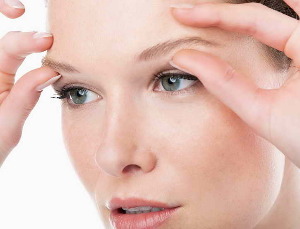
Eyelid lift is a set of equipment, infusion and manual manipulations aimed at rejuvenating and modeling the peripheral area (the area around the eyes). This part of the face is considered a zone of increased sensitivity, therefore, non-surgical cosmetic eyelid correction is a difficult task even for a qualified specialist with extensive experience. Microsurgical cosmetology and aesthetic medicine today offer several effective methods of eyelid lift: radiofrequency ablation, bio-enhancement with threads, contour plastics, photorejuvenation, microwave therapy. You can choose the most appropriate technique only after a visual examination of the problem area, studying the patient's medical history, goals and ideas about what the end result should be.
Peculiarities of the peripheral youth elevation
The eyelid area, also called the perinatal area (which is not entirely true, as the lacrimal apparatus, eyelash crack and conjunctival sac also belong to the peripheral area, except for the eyelids), is afrom the most sensitive areas of the human body with a thin layer of skin and minimal subcutaneous fat. The eyelids are muscular skin folds, bordered behind the conjunctiva and cartilage. They are located around the eye and perform many functions at the same time: protect the cornea and retina from the negative effects of environmental factors (ultraviolet radiation, dust, etc. ), clean the connective tissue membrane due to continuous wetting with wet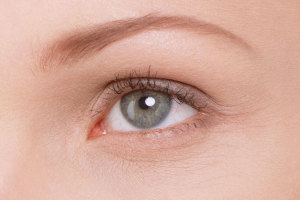 preventing the dry eye and cornea from drying out.
preventing the dry eye and cornea from drying out.
The skin in the eyelid area is several times thinner compared to other parts of the face, so it is more prone to age-related and stressful changes, which in most people are felt after 30 years. At this age, the process of natural dehydration of the body begins, resulting in the loss of moisture of the skin cells and the skin loses its elasticity, becomes loose and relaxed. In the peripheral zone in men and women over 30 years the first signs of aging are formed: hypodynamic folds, mimics wrinkles, folds in the outer corners of the eyes ("crow's feet").
Lifting the eyelids is a complex task that should be performed only by a specialized doctor with excellent knowledge of topographic anatomy of the eye, as improper actions can not only cause new defects, but also seriously damage the function of the organs. of vision. The fact is that the eyelids are involved in the formation of the focus of the eyes and the optical geometry of the cornea, as well as in the regulation of intraocular pressure, therefore, improper plastic surgery and lifting can cause visual dysfunction (in some cases, irreversible).Who needs eyelid lift
Lifting the peripheral zone has no strict medical indications (with the exception of surgical correction, which is often used to treat pathologies that interfere with the normal functioning of the visual organs) and is usually performed at the request of the patient to eliminate visual sensations. defects. Cosmetic and plastic surgeons include the following defects in such disadvantages:
- strong protrusion of the hyperrhythmic aspect.
- excess skin in the intrathecal myodermal fold.
- tilting the outer corners of the eyes.
- peripheral protrusions (fatty hernias);
- peripheral edema (sacs);
- vascular pathologies that lead to the appearance of traces of rosacea and dark circles under the eyes.
- hypodynamic wrinkles?
- "crow's feet" (folds in the corners of the eyes).
- strong intestinal grooves?
- "aging of the eyelids" (wilting and sagging of the eyelid skin).
Lifting the eyelids also helps to create a fresher and more open appearance, correcting the protrusions of the skin and peripheral fat sacs and improving the overall tone of the area.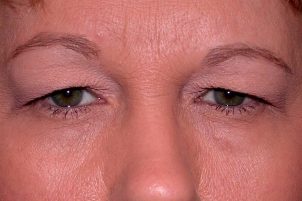 Early use of various methods of rejuvenating the area around the eyes helps to solve one of the main tasks of lifting peripheral relatives - to hide age-related changes in the skin and get rid of the visual defects that characterizebiological aging of the skin against the background of the reduction of the functional potential of the epidermal cells.
Early use of various methods of rejuvenating the area around the eyes helps to solve one of the main tasks of lifting peripheral relatives - to hide age-related changes in the skin and get rid of the visual defects that characterizebiological aging of the skin against the background of the reduction of the functional potential of the epidermal cells.
Important! Aging and heavy eyelids are a rather serious aesthetic defect that can ruin even a young and attractive face. For some, signs of skin aging in this area may appear even before the age of thirty (for example, in patients with underweight or in a person with endocrine system pathologies). As a rule, cosmetics are ineffective in correcting existing problems and are only suitable for preventing premature aging, so the only effective way to treat this defect is to lift the peripherals.
Eyelid lifting surgery
An operation to lift the skin on the upper and lower eyelids is called eyelid surgery. This is a kind of radical elevation of the peripheral zone, in which the effect of tightening and rejuvenation is achieved by the complete removal of excess skin and oily hernias in the eyelid area.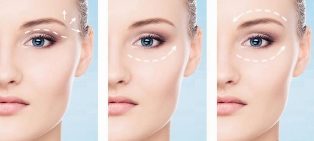 Unlike non-surgical methods of eyelid lift, eyelid surgery not only corrects the defects of aging skin and improves the appearance of this area, but also corrects the shape and shape of the eyes, as well asrelief from various pathologies.
Unlike non-surgical methods of eyelid lift, eyelid surgery not only corrects the defects of aging skin and improves the appearance of this area, but also corrects the shape and shape of the eyes, as well asrelief from various pathologies.
Eyelid surgery is effective for serious eye conditions such as entropy (swelling of the lashes and the tip of the eyelid towards the eyeball) or exophthalmos (displacement of the eyeball out of orbit). In total, there are three types of eyelid surgery: upper, lower and circular.
Table. Types of Radical Recovery of Peripheral Organs
| Operating Type | Module area | What pathologies can be corrected |
|---|---|---|
| Supraorbital blepharoplasty | An incision made in the skin along the orbital or tarsal fold of the upper eyelid. | Removal of excess skin, subcutaneous fat and muscle plastic. |
| Auxiliary eyelid surgery | Transdermal or secondary incision is made. | Removal of peripheral edema, bags under the eyes, fatty hernias. |
| Circular eyelid surgery | Simultaneous eyelid surgery on both sides. | Solve problems that are common to all types of eyelid surgery. |
The peripheral tightening operation is performed strictly in a hospital setting, excluding the possibility of outpatient surgery. The patient receives general anesthesia and the duration of the intervention is, on average, about 3 hours. A major disadvantage of this method of eyelid lift is the postoperative period, which, although short in duration (about two weeks), is characterized by pain, the need for regular effects and antiseptic treatment, and significant restrictions on status and professional activities.
Important! The advantage of eyelid surgery is the ability not only to tighten the skin of the eyelids, but also to perform plastic muscle tissue surgery, which can not be achieved using material and other minimally invasive methods.
Tightening of the peripheral zone without surgery
Surgical eyelid lift is a very effective method of radically rejuvenating the area around the eyes, but experts advise focusing only on older patients (after 40 years) with severe signs of aging and skin changes thatassociated with deep age. Before you reach this age, while tissue hydrodynamics are in the normal range, there are many less traumatic ways to correct existing problems, and the effectiveness of most of these techniques in some cases can be compared to the effect of plastic surgery. .Injection plastic (contour)
The plastic contour is probably the safest method of tightening the skin of the eyelids, which is related to mesotherapy procedures in terms of its technique. The outline is the subcutaneous injection of special implants called fillers.
These are preparations in the form of a homogeneous and viscous suspension or gel based on ingredients that have a high degree of affinity for body tissues. These can be:
- hyaluronic acid; calcium hydroxyapatite;
- collagen (a peptide composed of fibroblasts which is one of the main components of the extracellular substance of the skin, which ensures its elasticity and ability to stretch).
- polymers based on acrylic and methacrylic acid.
- high molecular weight oxygenated silicone?
- polylactic acid?
- salts of tripolyphosphoric acid etc.
The most popular and demanding fillers for lifting the peripheral head are hyaluronic acid based preparations. These are biodegradable (absorbable) skin implants, which not only compensate for the lack of tissue in this area, but also help eliminate wrinkles - one of the main visual signs of facial aging. The advantages of hyaluronic fillers include high hypoallergenicity and excellent results, which can be appreciated immediately after implantation. Hyaluronic acid bioabsorption occurs within several weeks, after which the injections must be repeated.
Biosynthetic implants based on polylactic acid and calcium hydroxyapatite retain their properties for 1-2 years.
RF Elevation
Elevating radio waves or radio frequencies is a non-surgical procedure to elevate the area around the eyes with a high degree of efficiency.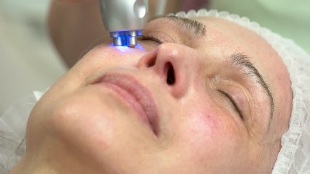 Among the material techniques for minimally invasive lifting of the skin of the upper and lower eyelids, RF lifting takes the lead, as it allows not only to achieve an immediate tightening effect, but also to significantly improve the condition of the skin in the perinatal zone. .
Among the material techniques for minimally invasive lifting of the skin of the upper and lower eyelids, RF lifting takes the lead, as it allows not only to achieve an immediate tightening effect, but also to significantly improve the condition of the skin in the perinatal zone. .
The radio waves, which penetrate the skin to the required depth, heat the epidermal cells to a temperature of collagen density, which is about 60 ° C. Under the influence of thermal energy, the skin tissue heats up, a partial withdrawal of the collagen frame occurs. , as a result of which the loose collagen fibers shrink again and take on their characteristic spiral shape, which is the lifting effect.
Radiofrequency ablation is suitable for correcting all age-related problems in the area around the eyes (crow's feet, hypotensive wrinkles, eyelid ptosis, etc. ) and the result is lasting up to 1-2 years. To achieve a consistent rejuvenating effect, you will need to perform about 6-10 procedures with an interval of at least 7-10 days.
Threaded bioinforcement (thread lifting)
Flossing is a process of rejuvenating the area around the eyes, which is based on the implantation of special cosmetic floss from various metals and synthetic materials under the skin, as a result of which a new collagen frame is formed in the subcutaneous layers. The procedure is quite effective and allows you to deal with the problem of "aging eyelids", oily peripheral hernias, the effects of gravity and other phenomena that characterize the aging of the skin.There are several types of yarn lifting threads. Precious metal yarns are in great demand in cosmetology. These yarns are made of platinum or gold and are designed to strengthen the upper layers of the skin. Gold threads not only provide a visible lifting effect, but also stimulate cellular metabolism, improving the supply of nutrients, oxygen and vitamins to skin cells. Serious disadvantages of precious metal yarns are the high risk of detachment and the impossibility of using many cosmetic procedures, for example photothermolysis after reinforcement.
Liquid mediastinum is mainly used to combat small sub-dynamic aspects, correct "eyelid aging" and smooth the skin in the peripheral area. The duration of such a procedure does not exceed 20-30 minutes, but the strengthening with wet threads has many contraindications and is always accompanied by various side effects (swelling, bruising, redness). Experts believe that the most effective type of lifting eyelid threads are the threads of Switzerland, Polylactic and Korean. The effect after such an enhancement lasts about 2-3 years.
Fractional photothermolysis
Fractional photothermolysis is another effective method of non-surgical tightening of the skin of the upper and lower eyelids. This is a type of laser rejuvenation in which a fractional laser generator (for example, an erbium laser) is used to affect the problem area. The beam created by this device is scattered in many streams and, when it hits the skin, forms a large number of microthermal treatment zones, in which the main effect takes place, therefore, the surrounding tissues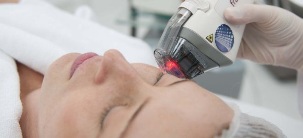 are not heated and are not injured.
are not heated and are not injured.
A special feature and at the same time the main principle of action of fractional photothermolysis is the heating of the skin to a temperature of 250-300 ° C, which experts call the evaporation process. Old, pathologically damaged and damaged cells under the influence of this temperature are destroyed and evaporated, while natural neocollagenesis is activated and the activity of fibroblasts, which compose the main components of the extracellular matrix - peptides (collagen and elastin), increases.
The result of fractional laser rejuvenation is a remarkable tightening of the skin on the eyelids, smoothing out wrinkles and creases, restoring the hydrodynamics of peripheral tissues and improving the general condition of the skin in this area.
Pulse currents (small currents)
Treatment with microcurrents refers to low traumatic methods of eyelid lift, but a major disadvantage of this method is the short duration of the effect (not more than 4 months). The clinical result from the use of microtherapy for the elevation of the peripheral zone is due to the following properties of pulsed currents:
- normalize lymph flow.The effect of lymphatic drainage, which has pulsating currents on the skin, improves lymph movement, prevents stagnation and helps reduce dark circles under the eyes.
- stimulation of metabolic processes.Activation of cellular metabolism has a positive effect on oxygen and nutrient transport and skin appearance (skin becomes smooth, acquires a healthy appearance).
- restoration of muscle tone.The eyelid muscles are quite weak and the extra stimulation allows you to achieve a tightening effect.
The normal duration of the course is from 10 to 20 procedures, while in most cases it becomes necessary to repeat the procedure after a few months.

Before and after photos
Conclusion
Lifting eyelids is a difficult but at the same time feasible task, for the solution of which modern aesthetic medicine offers a large number of effective methods, including low-level traumatic manipulations with a low probability of complications. Which method of lifting the peripheral head will be the most effective and safe is decided individually after talking with the patient, diagnosing the problem area and studying the medical history dataThe use of surgical techniques is mainly indicated for patients with strong signs of aging in the area around the eyes, in which the use of gentle techniques is ineffective and will probably not give a consistent positive result. People with the initial manifestations of the "aging century" prefer to choose minimally invasive methods with a low degree of tissue trauma and a short recovery period.
























































